nn
n
n Submerged beneath a southern sea, inside a shellnsomething stirs. It itches, it irritates and a shellfish flinches. It flexes,nundulating its body and tries to rid itself of the intruder, but to no avail.nThe thing will not be moved. So the shellfish begins the long process ofncovering the irritating interloper with nacre, in layer after layer, until,ninstead of an unwanted incursion, there is a smooth sphere that now longernscratches the mollusc’s delicate body. And this sphere is now very much wantednindeed, as it is now a pearl.
n
n
n
 |
| The internal structure of a bi-valve |
n
n
n
nIt’s a common misconception that pearls arenformed when a grain of sand makes its way into an oyster shell, but thenintruder is more likely to be a tiny parasite, the larva of anothernsea-creature or one of the oyster’s own eggs that gets covered innmother-of-pearl. It’s not just oysters either, as many bi-valve molluscs formnpearls around invading irritants, including mussels and clams. The shells ofnmany molluscs and brachiopods are made up of three layers; an outer layer, callednthe periostracum, a middle prismatic layer and an inner nacreousnlayer.
n
n
n
 |
| The Pearl Fishers |
n
n
n
nInside the shell, the mantle, a flap or fold of flesh, covers all ofneither the right or left side of the nacreous layer, and forms a ridge ornmargin at the outermost edge, from which the two outermost layers are produced,nwhilst the rest of the mantle secretes the pearly inner layer. Should anirritating particle or parasite become lodged between the mantle and the uppernlayers, nacre is secreted over it and it is incorporated into the body of thenshell, whereas something that enters the interior of the creature becomesncovered in layers of nacre and a pearl is produced.
n
n
n
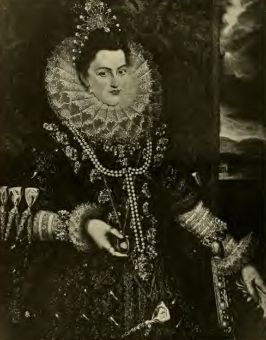 |
| Clara Eugenia of Spain in her Pearls |
n
n
n
n
n
nAt first, the layersnconform to the contours of the foreign body, but over time the increasingnnumbers of layers tend to produce a spheroidal or spherical shape, unless thenintrusion is so pronounced that an irregular – or baroque – pearl is made, andnthese command a lower price, purely on aesthetic grounds. It is reasonable tonassume that pearls were the earliest of valued gems, as fish-eating ancientnpeoples would have inevitably have come across them, and their immediatennatural beauty, free from the need of further art to enhance it, must havenensured their desirability.
n
n
n
 |
| The Rana of Dholpur in his Pearls |
n
n
n
nPearls appear in the ancient Indian religious texts,nthe Ramayana and the Mahabharata, and in Hindu mythology thenpearl is associated with Krishna, the eighth avatar of Vishnu, who drew onenfrom the sea to adorn his daughter, Pandaia, on her wedding day.
n
n
n
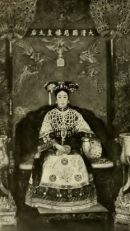 |
| The Dowager Empress of China in her Pearls |
n
n
n
nIn the ancientnCingalese chronicles, the Mahavansa and the Dipavansa, pearls arenmentioned as being sent as gifts from Ceylon; the Chinese Shu King notesnthat, in the twenty-third century BCE, Yü received river pearls in tribute, andnthe ancient Chinese dictionary the Ny’ha (c.1000 BCE) mentions pearls asnprecious jewels that come from Shen-si province.
n
n
n
n
n
n
n
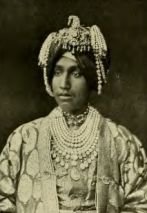 |
| The Maharajah of Patiala in his Pearls |
n
n
n
n
n
n
nAuthorities vary in theirnopinion on the translations of various words for precious jewels in the OldnTestament, but there are numerous mentions of pearls in the New Testament, asnthere are in the Talmud, where they signify something either very costly ornvery beautiful.
n
n
n
 |
| The Ashburnham Gospel decorated with Pearls |
n
n
n
nThe Quran has pearls aplenty too, particularly in Paradise,nwhere the trees bear pearls and emeralds. Ancient Greek writers mention pearlsnas early at the fifth century BCE, and later Roman writers like Pliny writenabout them, including a description of Pompey’s victory parade wherenthirty-three crowns of pearls were displayed. The Emperor Caligula had pearlsnsewn into the harness of Incitatus, his favourite horse that legend says henraised to the rank of Senator, and he wore slippers embroidered with pearls.
n
n
n
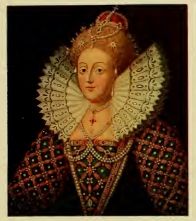 |
| Elizabeth I in her Pearls |
n
n
n
nBynthe Middle Ages, every Emperor, King or Pope worth his salt would have hisnregalia made from gold and studded with diamonds, jewels and pearls. At thenmeeting of Henry VIII and Francis I at the Field of the Cloth of Gold, in 1520,nthe banqueting chamber was decorated with embroidered gold and pearl hangings,nwhen Henry was introduced to Anne of Cleves, he wore a coat of purple velvetnwith clasps made from gold, diamonds, rubies and oriental pearls, and Anne’snwedding gown was made from cloth of gold embroidered with large flowers madenfrom pearls.
n
n
n
 |
| Elizabeth of France in her Pearls |
n
n
n
nWhen the New World was discovered, a new source of pearls emerged;nMontezuma gave precious gifts to Cortez, who returned these golden presents,nwith emeralds, rubies and pearls, to Europe. The high walls and the roof of thentemple of Tolomecco were made from mother of pearl, with strings of pearls andnplumes of feathers hanging from the walls, the graves of its kings had shieldsnadorned with pearls placed over them, and in the centre of the temple werenvases filled with costly pearls.
n
n
n
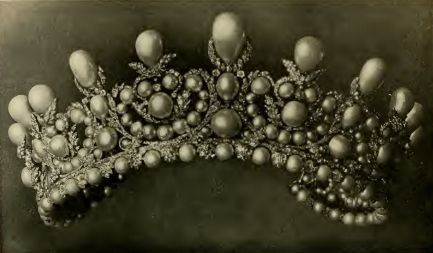 |
| Grand Pearl Diadem of the French Crown Jewels |
n
n
n
nPearls flooded back to the courts of Europe;nMarie de Medici wore a gown to the christening of her son that was decoratednwith 3,000 diamonds and 32,000 pearls, and the Elector Maximilian of Bavariansent his future bride a present of a necklace of 300 selected pearls, eachnworth 1,000 guldens.
nnn
n
n
 |
| The Czarina of Russia in her Pearls |
n
n
nnn
nTomorrow – Myth and Magic of Pearls
nnn
n
nnn
n
